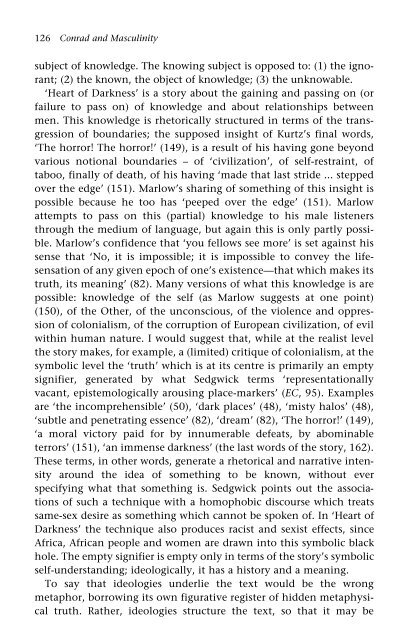Conrad and Masculinity
Conrad and Masculinity
Conrad and Masculinity
Create successful ePaper yourself
Turn your PDF publications into a flip-book with our unique Google optimized e-Paper software.
126 <strong>Conrad</strong> <strong>and</strong> <strong>Masculinity</strong><br />
subject of knowledge. The knowing subject is opposed to: (1) the ignorant;<br />
(2) the known, the object of knowledge; (3) the unknowable.<br />
‘Heart of Darkness’ is a story about the gaining <strong>and</strong> passing on (or<br />
failure to pass on) of knowledge <strong>and</strong> about relationships between<br />
men. This knowledge is rhetorically structured in terms of the transgression<br />
of boundaries; the supposed insight of Kurtz’s final words,<br />
‘The horror! The horror!’ (149), is a result of his having gone beyond<br />
various notional boundaries – of ‘civilization’, of self-restraint, of<br />
taboo, finally of death, of his having ‘made that last stride ... stepped<br />
over the edge’ (151). Marlow’s sharing of something of this insight is<br />
possible because he too has ‘peeped over the edge’ (151). Marlow<br />
attempts to pass on this (partial) knowledge to his male listeners<br />
through the medium of language, but again this is only partly possible.<br />
Marlow’s confidence that ‘you fellows see more’ is set against his<br />
sense that ‘No, it is impossible; it is impossible to convey the lifesensation<br />
of any given epoch of one’s existence—that which makes its<br />
truth, its meaning’ (82). Many versions of what this knowledge is are<br />
possible: knowledge of the self (as Marlow suggests at one point)<br />
(150), of the Other, of the unconscious, of the violence <strong>and</strong> oppression<br />
of colonialism, of the corruption of European civilization, of evil<br />
within human nature. I would suggest that, while at the realist level<br />
the story makes, for example, a (limited) critique of colonialism, at the<br />
symbolic level the ‘truth’ which is at its centre is primarily an empty<br />
signifier, generated by what Sedgwick terms ‘representationally<br />
vacant, epistemologically arousing place-markers’ (EC, 95). Examples<br />
are ‘the incomprehensible’ (50), ‘dark places’ (48), ‘misty halos’ (48),<br />
‘subtle <strong>and</strong> penetrating essence’ (82), ‘dream’ (82), ‘The horror!’ (149),<br />
‘a moral victory paid for by innumerable defeats, by abominable<br />
terrors’ (151), ‘an immense darkness’ (the last words of the story, 162).<br />
These terms, in other words, generate a rhetorical <strong>and</strong> narrative intensity<br />
around the idea of something to be known, without ever<br />
specifying what that something is. Sedgwick points out the associations<br />
of such a technique with a homophobic discourse which treats<br />
same-sex desire as something which cannot be spoken of. In ‘Heart of<br />
Darkness’ the technique also produces racist <strong>and</strong> sexist effects, since<br />
Africa, African people <strong>and</strong> women are drawn into this symbolic black<br />
hole. The empty signifier is empty only in terms of the story’s symbolic<br />
self-underst<strong>and</strong>ing; ideologically, it has a history <strong>and</strong> a meaning.<br />
To say that ideologies underlie the text would be the wrong<br />
metaphor, borrowing its own figurative register of hidden metaphysical<br />
truth. Rather, ideologies structure the text, so that it may be




